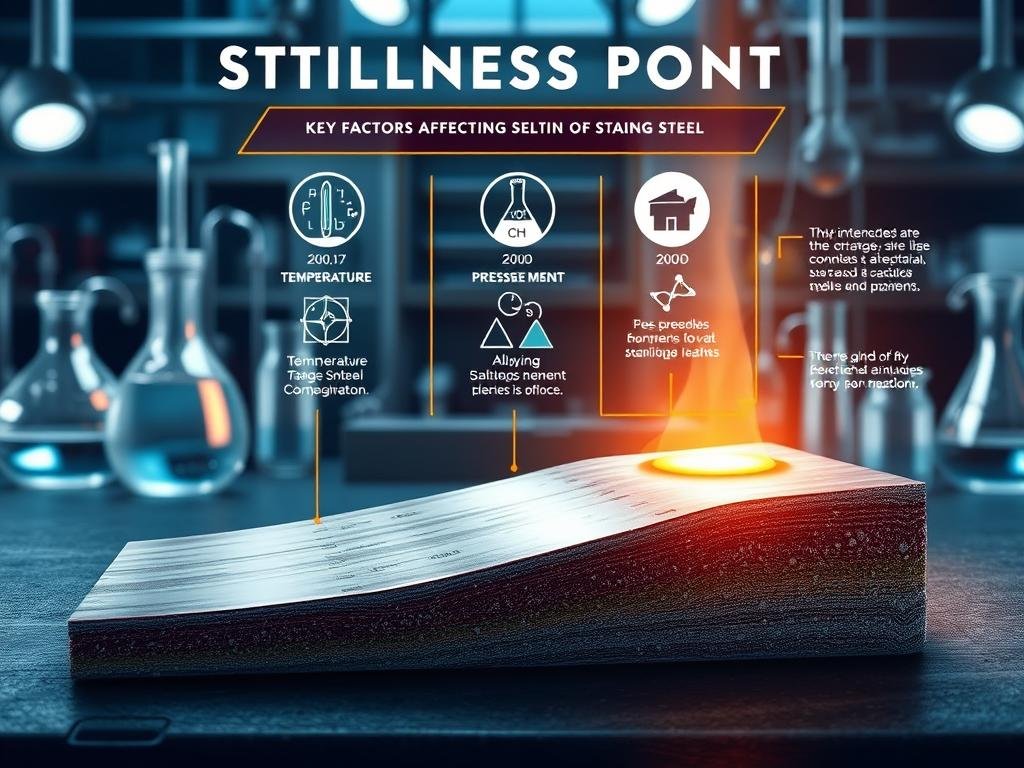Stainless steel is renowned for its exceptional corrosion resistance and durability, making it a versatile alloy in various industrial and commercial applications.
The temperature at which stainless steel melts is not fixed, unlike pure metals, but rather falls within a range of 1,370 to 1,530 degrees Celsius.
This variation is due to the different grades of steel and the proportion of metals used in the alloy, affecting its melting behavior.
Understanding the melting point of stainless steel is crucial for engineers and manufacturers working with this material in high-temperature environments.
Understanding Melting Points in Metals
Understanding the melting point of metals is essential for various industrial applications. The melting point is a critical property that determines how a metal behaves under different temperature conditions.
What Is a Melting Point?
A melting point is the temperature at which a metal transitions from a solid to a liquid state. Pure metals have a precise melting point, whereas alloys exhibit a melting range due to their complex composition.
How Melting Points Differ Between Pure Metals and Alloys
Pure metals like iron have a sharp melting point, whereas alloys such as stainless steel alloy, which includes elements like chromium and nickel, melt over a range of temperatures. This phenomenon, known as melting point depression, occurs because the addition of different elements lowers the overall melting point.
The differences in melting behavior between pure metals and alloys are significant for metallurgical processes. Alloys display a melting range rather than a single melting point, influenced by the proportions and interactions of their constituent elements.
The Stainless Steel Melting Point Range
The melting point of stainless steel is not a single temperature but rather a range, influenced by its various alloying elements. This characteristic is crucial for understanding the material’s behavior under high-temperature conditions.
General Temperature Range for Stainless Steel
Stainless steel typically melts between 2,500°F and 2,800°F (1,371°C to 1,538°C), though this range can vary based on the specific grade and composition. The primary components, including iron, chromium, nickel, and carbon, each have different melting points, contributing to the overall melting range of the alloy.
- The exact melting range is influenced by the proportion of alloying elements.
- Different grades of stainless steel have distinct melting behaviors.
Why Stainless Steel Has a Melting Range Instead of a Fixed Point
Stainless steel is an alloy, not a pure metal, which means it doesn’t have a sharp melting point. Instead, it exhibits a melting range due to the presence of multiple elements with different melting temperatures. This phenomenon, known as “melting point depression,” results in a gradual transition from solid to liquid.
The interaction between the various elements in stainless steel creates a “mushy zone” during heating, where the material is partially solid and partially liquid. Understanding this melting range is essential for processes like casting and welding.
Melting Points Across Different Stainless Steel Grades
Stainless steel grades display diverse melting behaviors due to variations in their alloying elements. This diversity is crucial for selecting the appropriate grade for specific applications, especially those involving high temperatures.
Austenitic Stainless Steels (304, 316)
Austenitic stainless steels, such as grades 304 and 316, are widely used due to their excellent corrosion resistance and formability. Grade 304, one of the most common stainless steels, has a melting point range of 1400-1450°C. Grade 316, with its molybdenum addition, offers superior corrosion resistance and has a slightly lower melting point range of 1375-1400°C.
Ferritic and Martensitic Stainless Steels
Ferritic stainless steels, like grade 430, have a higher melting point range (1425-1510°C) compared to austenitic grades. This makes them suitable for high-temperature applications. Martensitic stainless steels also offer high strength and are used in applications requiring both corrosion resistance and high mechanical strength.
Comparison Chart of Common Grades and Their Melting Points
The melting points of various stainless steel grades are summarized in the following table:
| Grade | EN Specification | Melting Point (°C) |
|---|---|---|
| 301 | 1.4301 | 1400-1420 |
| 303 | 1.4305 | 1400-1420 |
| 304 | 1.4301 | 1400-1450 |
| 304L | 1.4307 | 1400-1450 |
| 316 | 1.4401 | 1375-1400 |
| 316L | 1.4404 | 1375-1400 |
| 321 | 1.4541 | 1400-1425 |
| 430 | 1.4016 | 1425-1510 |
Understanding the melting points of different stainless steel grades is essential for engineers and designers to ensure the material’s integrity in various applications, from kitchen utensils to industrial equipment.
Factors That Affect Stainless Steel’s Melting Point
The melting behavior of stainless steel is determined by a combination of intrinsic and external factors. Understanding these factors is crucial for predicting and controlling the melting point in various industrial applications.
Chemical Composition and Alloying Elements
The chemical composition of stainless steel plays a significant role in determining its melting point. Alloying elements such as chromium, nickel, and molybdenum can alter the melting behavior. For instance, the addition of nickel can lower the melting point, while chromium tends to increase it. The specific combination and proportion of these elements can result in a wide range of melting points among different stainless steel grades.
| Alloying Element | Effect on Melting Point |
|---|---|
| Chromium | Increases |
| Nickel | Decreases |
| Molybdenum | Variable |
Crystal Structure Influence
The crystal structure of stainless steel also influences its melting point. Different crystal structures, such as austenitic, ferritic, and martensitic, have distinct melting behaviors. For example, austenitic stainless steels tend to have a lower melting point compared to ferritic and martensitic grades due to their face-centered cubic structure.
External Factors: Pressure and Atmosphere
External factors like pressure and atmosphere can significantly affect the melting point of stainless steel. Increased pressure generally raises the melting point, as most materials require higher temperatures to melt under elevated pressure. The atmosphere surrounding the steel during heating can also impact its melting behavior, with oxidizing atmospheres potentially altering the surface composition.

As noted by experts, “the presence of certain gasses or contaminants in the atmosphere may influence the alloy’s behavior at high temperatures, making it critical to control environmental conditions in industrial applications.”
How to Determine the Melting Point of Stainless Steel
Accurate determination of the melting point is essential for the proper processing and application of stainless steel. This critical parameter influences various industrial processes, from casting and forging to welding and heat treatment.
Laboratory Methods and Testing Procedures
Laboratory methods for determining the melting point of stainless steel involve precise testing procedures. Techniques such as differential scanning calorimetry (DSC) and thermogravimetry (TG) are commonly used to analyze the thermal properties of stainless steel samples. These methods provide accurate data on the melting range of different stainless steel grades.
Industrial Applications of Melting Point Determination
In industrial settings, knowing the melting point of stainless steel is crucial for optimizing processes. For instance, foundries rely on precise melting point data to adjust furnace temperatures, ensuring complete melting while minimizing energy consumption. Additionally, welding procedures and heat treatment processes are developed based on melting point information to ensure the quality and integrity of stainless steel components.
Practical Implications of Stainless Steel’s Heat Resistance
High-temperature resistance is one of the defining characteristics of stainless steel that makes it invaluable in industrial settings. The properties of stainless steel are significantly affected by heat, impacting its tensile strength and overall performance.
High-Temperature Applications in Industry
In high-temperature applications, stainless steel’s ability to maintain its strength is crucial. Industries such as aerospace, power generation, and chemical processing rely on stainless steel for its resistance to damage from high temperatures. The material’s ability to withstand extreme heat without losing its integrity makes it an ideal choice for these applications.
How Heat Affects Stainless Steel’s Properties Before Melting
Before reaching its melting point, stainless steel undergoes significant changes in its mechanical properties as temperature increases. The tensile strength of stainless steel decreases as it is exposed to higher temperatures, affecting its performance. Understanding these changes is essential for designing components that will operate effectively in high-temperature environments.

Conclusion
Understanding the melting behavior of stainless steel is essential for manufacturers and end-users alike, given its widespread use in demanding environments.
The melting point of stainless steel, ranging from 1,370 to 1,530 degrees Celsius, is influenced by its alloy composition. Austenitic grades like 304 and 316 melt at lower temperatures than their ferritic and martensitic counterparts.
Selecting the appropriate grade based on its melting characteristics and high-temperature properties ensures optimal performance and safety. Factors such as pressure and atmospheric conditions also influence stainless steel’s behavior at high temperatures.
